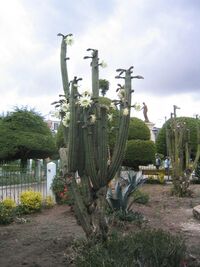Entheogen: Difference between revisions
>Unity Grammatics |
>Unity Grammatics. |
||
| Line 1: | Line 1: | ||
[[File:Flowering San Pedro cactus.jpg|200px|thumbnail|right|Flowering San Pedro, an entheogenic cactus that has been used for over 3,000 years<ref>http://www.mescaline.com/sanpedro/</ref>]] | [[File:Flowering San Pedro cactus.jpg|200px|thumbnail|right|Flowering San Pedro, an entheogenic cactus that has been used for over 3,000 years<ref>http://www.mescaline.com/sanpedro/</ref>]] | ||
'''Entheogens''' (" | '''Entheogens''' ("becoming the divine within") are a class of [[psychoactive substances]], typically of plant origin, that are used in religious, ritual, or spiritual contexts. [[Jonathan Ott]] is credited with coining the term in 1979.<ref>The Road to Eleusis (2008) By R. Gordon Wasson, Albert Hofmann, Carl A. P. Ruck, Huston Smith pg. 139</ref> | ||
Entheogens have been used in a ritualized context for thousands of years and their religious significance is well established with anthropological and academic literature. Examples of traditional entheogens include [[psychedelics]] like [[Lophophora williamsii (botany)|peyote]], [[psilocybin mushrooms]], [[ayahuasca]], and [[iboga]]; atypical [[hallucinogen]]s like [[salvia]] and ''[[Amanita muscaria]]''; quasi-psychedelics like [[cannabis]]; and [[deliriants]] like [[datura]]. | Entheogens have been used in a ritualized context for thousands of years and their religious significance is well established with anthropological and academic literature. Examples of traditional entheogens include [[psychedelics]] like [[Lophophora williamsii (botany)|peyote]], [[psilocybin mushrooms]], [[ayahuasca]], and [[iboga]]; atypical [[hallucinogen]]s like [[salvia]] and ''[[Amanita muscaria]]''; quasi-psychedelics like [[cannabis]]; and [[deliriants]] like [[datura]]. | ||
Revision as of 06:51, 4 November 2019

Entheogens ("becoming the divine within") are a class of psychoactive substances, typically of plant origin, that are used in religious, ritual, or spiritual contexts. Jonathan Ott is credited with coining the term in 1979.[2]
Entheogens have been used in a ritualized context for thousands of years and their religious significance is well established with anthropological and academic literature. Examples of traditional entheogens include psychedelics like peyote, psilocybin mushrooms, ayahuasca, and iboga; atypical hallucinogens like salvia and Amanita muscaria; quasi-psychedelics like cannabis; and deliriants like datura.
With the advent of organic chemistry, there now exist many synthetic drugs with similar psychoactive properties, many of which are derived from these plants. Many pure active compounds with psychoactive properties have been isolated from these respective organisms and synthesized chemically. These include the naturally occurring mescaline, psilocybin, DMT, salvinorin A, ibogaine, ergine, and muscimol, the semi-synthetic LSD, and synthetic substances (e.g., DPT used by the Temple of the True Inner Light and 2C-B used by the Sangoma).[3]
More broadly, the term entheogen is used to refer to any psychoactive substance used for its religious or spiritual effects, whether or not in a formal religious or traditional structure. This terminology is often chosen to contrast with the recreational use of the same substances. Studies such as the Marsh Chapel Experiment have documented reports of spiritual experiences from participants who were administered psychoactive substances in controlled trials.[4] Ongoing research is limited due to widespread drug prohibition; however, some countries have legislation that allows for traditional entheogen use.
See also
- Responsible use
- Naturally occurring sources
- Psychonautics
- Hallucinogen
- Psychedelic
- Dissociative
- Deliriant
External links
- Entheogen (Wikipedia)
- Entheogenic drugs and the archaeological record (Wikipedia)
- Psychedelics and ecology (Wikipedia)
- Entheogens (Erowid Vaults)
References
- ↑ http://www.mescaline.com/sanpedro/
- ↑ The Road to Eleusis (2008) By R. Gordon Wasson, Albert Hofmann, Carl A. P. Ruck, Huston Smith pg. 139
- ↑ http://evolver.civicactions.net/user/chen_cho_dorge/blog/2cb_chosen_over_traditional_entheogens_south_african_healers
- ↑ http://www.springerlink.com/content/v2175688r1w4862x/fulltext.pdf